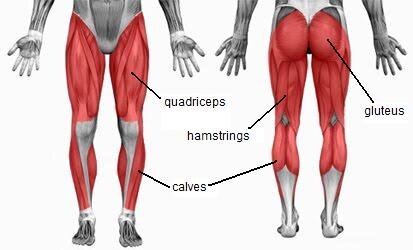For part 4 of our running series, we’re going to talk a bit about what muscles you should work on, and how!
Anatomy
Muscles
Firstly, I think we all need to know a bit more about where the muscles are, in order to work on getting them stronger. I am going to keep it fairly simple, but please ask your physiotherapist for more information if you need it.
The main muscle groups in our legs are;
The gluteal muscles (glutes)
The quadriceps muscles (quads)
The hamstring muscles (hams)
The calf muscles (calves)
Each of these groups is made up of between 3 – 4 different muscles. But you don’t need to worry too much about that, unless there is a problem with one of them.
These muscle groups are important for all the activities we do, especially running. When we run, we put up to 3 times our body weight through our legs! This means we need to keep our muscles strong to cope with that load.
Tendons
We also have tendons that come from these muscle groups. The tendon is the part that attaches the muscle group to the bone.
For example, our Achilles tendon, which attaches our calf muscles to our heel bone.
The tendons are different to muscles, as their blood supply is not as good. This means it takes tendons longer than muscles to heal. Which is why tendinopathy can take a long time to recover – read more here on common tendon problems in the legs.
Now that we know a bit more about the anatomy, let us look at how to get these groups of muscles and these tendons stronger.
Exercises
I have split the muscle groups below and created a video to demonstrate the exercises for you. Read the brief explanation, and then watch the video below. And remember – a lot of these exercises work other muscles too! If you are struggling or don’t think these exercises are working for you, talk to your physiotherapist.
Do not do these exercises if you are in pain or have any serious medical condition (heart/lung problems, cancer, inflammatory conditions, etc.) unless your medical professional has advised you it is ok to do so.
Forward step up
This one is for your glutes. Step up onto a step. Push up to straighten your knee, use your bottom muscles to help. Bring the other leg through and lift it up. Then slowly bend your knee to lower the other leg back and down. Repeat.
Single leg squat
Another one for your glutes. Stand on one leg and bend the knee you are standing on. Hold onto something for balance if needed. Make sure you don’t let your knee roll inwards or outwards and keep the pelvis level. Repeat.
Wall Squat
You’ll find there is some overlap with quads strengthening and different exercises, but this is one I like to use. Stand with your back against a wall, making sure your feet are away from the wall. Squat down by sliding your bottom down the wall. Hold 10-20 seconds. Push up to stand and then repeat.
Supine leg curl
For your hamstrings. Lie on your front, arms relaxed. Bend one knee up towards you, so your heel comes towards your bottom. Slowly lower back down. Repeat.
To make this harder, add an ankle weight, or use a resistance band around the back of your ankle and tie it to something secure.
Double or Single Leg Bridge
Another one for the hamstrings. Start in lying with knees bent to about 90 degrees. Keep knees hip distance apart. Slowly roll so your bottom lifts off the bed/floor, followed by your back. Make sure your pelvis stays level once you are at the top of the bridge, and your knees don’t roll inwards. Then slowly lower back down.
Progress to doing this with one leg only if needed. Repeat.
Soleus calf raises
Another way to work on some of the deeper calf muscles, is to do heel raises with the knees bent, like in the video.
See another calf strengthening exercise in this blog here.
And, remember, we don’t know it all… Recent research suggests there is further study needed on whether these strength changes transfer across to running, so let’s see what happens in the future!
(Trowell, et al. 2020)
Other references: (REIMAN ET AL. 2012; ZEBIS ET AL. 2013)







